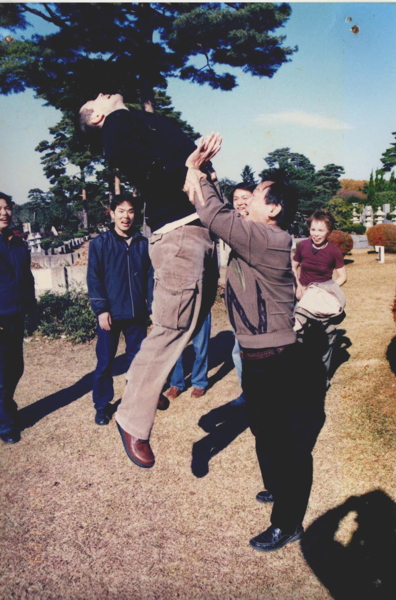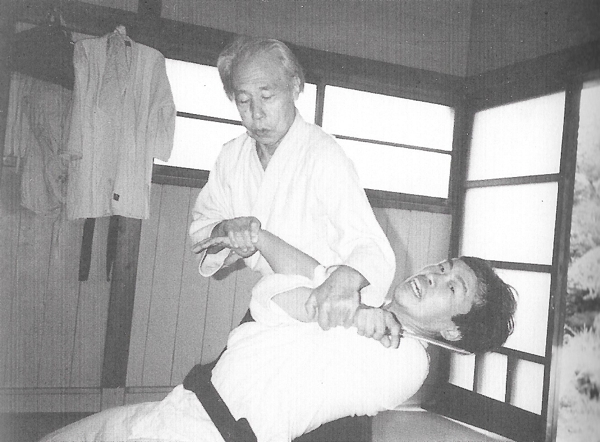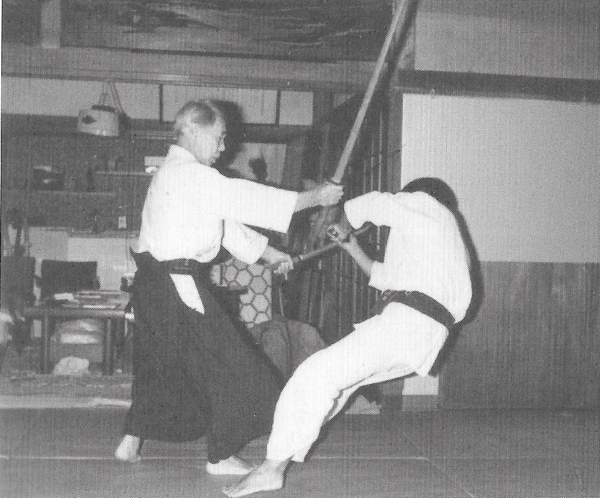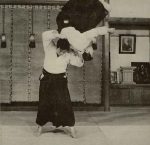Tatsuo Kimura demonstrates Aiki-age
Stretching his right hand upward, Morihei Sensei said, “Those who practice Aiki should understand the heart of faraway America.”
I immediately thought to myself, “Please come and throw me,” expecting that Morihei Sensei would read my thoughts. Of course, this was merely something I thought in my own mind. However, at that instant, Morihei Sensei, who was looking out the window, turned to me. To my surprise, he started to walk in my direction. He was small, about 150 cm tall, but at that time I felt he was very big. It seemed to me that there was a big wall in back of Morihei Sensei and it was approaching me powerfully. Since I had never taken a fall for Morihei Sensei up until that time, I became very tense. I thought to myself, “Oh no! What shall I do?” as he approached very close to me. He raised his right hand up as if to execute an iriminage throw and shouted, “Eii!” I fell backward. Then, turning to me, Morihei Sensei said, “That was good!” Then, I bowed down with both hands touching the tatami mumbling, “Ha-ha.”
I was really surprised by this. I felt that he read my thoughts at that instant. He had a powerful aura about him and an amazing kiai.
Morihei Sensei often appeared in the Hombu Dojo during Seigo Yamaguchi Sensei’s practice. One day, Morihei Sensei started to explain the kotegaeshi technique while holding Yamaguchi Sensei’s right hand with his left hand. Then Morihei Sensei applied a pressure on Yamaguchi Sensei’s right hand with his right hand. Yamaguchi Sensei hesitated an instant and then took the fall by himself. Suddenly, Morihei Sensei, who was smiling until then, shouted at us, “Do not practice so that if someone moves a certain way, the other person falls in a certain way!” Morihei Sensei’s voice had a metallic sound that could be heard far away.
His eyes flashed and I suddenly felt thunder coming down from the fine blue sky. I was really surprised. In this sense, Morihei Sensei was not a normal person. His spirit and kiai were really extraordinary I had never seen such a person up until that time.
The atmosphere was completely different when Morihei Sensei was performing techniques compared to the other instructors. When I look at the videos of Morihei Sensei I cannot feel his “ki” and more than half of the information is lost. It seems that the camera cannot capture the atmosphere or the feeling of the dojo. Actually, there was a certain tension in the air when Morihei Sensei was present.
…..Frankly speaking, when Morihei Ueshiba died, I felt Aikido was finished. It disappeared from the world because the Aikido of Morihei Ueshiba and that of his students are completely different.
Tatsuo Kimura
from “Discovering Aiki My 20 Years with Yukiyoshi Sagawa Sensei“
Tatsuo Kimura (木村達雄), born in Tokyo Japan in 1947, is a well known mathematician and professor at Tsukuba University. He was also a long-time student of the famous Daito-ryu instructor Yukiyoshi Sagawa (佐川幸義). He published two books about Sagawa Sohan (宗範) that have been translated into English (the latter one only partially) – “Transparent Power (透明な力)” and “Discovering Aiki My 20 Years with Yukiyoshi Sagawa Sensei (合気修得への道―佐川幸義先生に就いた二十年)”. He also holds a third-dan in kendo and a fifth-dan in Aikido, which he studied under Seigo Yamaguchi (山口清吾).
This is the first part of a two part interview that appeared in Japanese in the book “Daito-ryu Aiki Bujutsu Sagawa Yukiyoshi, Divine Techniques of Aiki – Signposts to ‘Aiki’, a miraculous technical method that surpasses strength” (大東流合気武術 佐川幸義 神業の合気 力を超える奇跡の技法“合気”への道標), which was published in March 2015 by BAB Japan publishing company (BABジャパン出版局), which also publishes the popular martial arts magazine Gekkan Hiden (月刊秘伝 / “Secret Teachings Monthly”).
Yukiyoshi Sagawa Sohan in his youth
Yukiyoshi Sagawa’s Aiki, a true portrait of Transparent Power – Part 1
Interview with Tatsuo Kimura
Meeting Sagawa Sohan
Q: When was it that you first met Sagawa Sensei?
A: It was on November 28th of Showa year 53 (1978). I had been practicing Aikido day in and day out since the third year of middle school, had taught it overseas, and had established an Aikido club at Nagoya University – that was how soaked in Aikido my existence was. At the time I was an assistant instructor at Nagoya University, and I learned of Sagawa Sensei through a book called “Hiden Nihon Jujutsu” (by Ryuchi Matsuda / 松田隆智, published by Shin-jinbutsuraisha / 新人物往来社). So I wrote a letter and went to meet him.
 Hiden Nihon Jujutsu (秘伝日本柔術)
Hiden Nihon Jujutsu (秘伝日本柔術)
by Ryuchi Matsuda (松田隆智)
In the dojo I was taken to the reception room, but at the time I wasn’t aware that Sagawa Sensei was such an important person so I spouted off about the things that I had done in Aikido and about how great Ueshiba Sensei had been in front of him! When I think about it now I break out in a cold sweat… (laughing)
Then Sensei said “try holding down both of my hands!”, so I did as he told me and held down both of his hands from above while he remained sitting on the sofa. At the time Sensei was around 76 years old, so speaking from the common sense of the Aikido that I had practiced I thought that there was no way that such an old man would be able to do anything if I held him down seriously, but when I held him down lightly he said “Is that all the strength that you have? What a pitiful fellow…hold me down seriously!”, and since he insisted I held him down with all my strength. As I did that, before I could understand what was going on I was shooting backwards. Normally, if one holds someone down firmly from above then no matter what their strength will collide with you, but there was nothing like that, I was destabilized in an instant. Then Sensei stood up and said “try grabbing my collar”, but when I grabbed the collar of the sweater that he was wearing I was thrown to the floor with just a slight movement of his body.
Then I said “one more time please” and tried grabbing both of his arms with all my strength, holding onto his legs, just trying whatever I could, but no matter how many times I tried I fell just the same. I was really shocked. But when I took his hand right there and said “please allow me to become your student” he refused me with “Dame da!” (“No!”) right away.
The Reality of Sagawa Dojo
Q: What is the truth behind the strict selection of students?
A: It was certainly strict. In any case, as far as I was concerned my heart was filled with joy that I had finally found the real thing, and I thought that I wanted to gain entrance no matter what. Once more I wrote a polite letter, but then I was told “I will allow you to become a student, but I won’t teach you!”. What he meant was that in Sagawa Sensei’s dojo the beginners were taught by the students, and Sensei wouldn’t give them any direction. As one’s capability and dedication was recognized they would become able to be taught directly by Sensei.
For that reason I was left alone in the beginning, and I was extremely jealous of those people who were able to take Sensei’s hand and be taught. But I thought that I should be grateful just to be allowed to become a student, and somehow continued my training through worries and impatience. Then gradually I became able to receive direction and instruction in technique, and became able to take his hand and be taught directly.
Tatsuo Kimura being thrown by Yukiyoshi Sagawa
at a seminar for the 3rd Gen techniques, May 1982
Q: What was training in the dojo like?
A: In the case of Sagawa Dojo, the beginning student’s techniques had absolutely no effect on the older students. It wasn’t a matter of using strength to resist, the partner’s arms came down as if they were dangling and they weren’t even intimidating. Their bodies were completely different. I did Aikido for fifteen years, but in the end my body was no different from a novice. We would fly for each other, so my body was essentially unchanged.
In Sagawa Dojo technique cannot be applied at first, and as one trains their bodies gradually become stronger. So the toughness in the bodies of those who have trained three years, five years, ten years, or twenty years is completely different. They look the same, though. In any case, it is a kind of toughness of the body that I had never seen in Aikido – I thought that they were a group of monsters! (laughing) But that is the way that they would train and without realizing it they would certainly become strong.
Q: At Sagawa Dojo the training was primarily the repetition of technique, wasn’t it?
A: That’s so, but if the technique didn’t work it was okay not to fall – I think that it may have been a strength that came through taking that as a pre-condition for training. So, when one reached a certain level the techniques become ineffective between the students. Sagawa Sensei could apply technique to them extremely easily. For example, Nikajo – in Aikido one would say Nikyo – at some point this would stop working, but when Sagawa Sensei applied it no who it was or how hard they struggled they would crumble straight down. Watching that really started my aspirations boiling.
However, and this is something that I have gradually come to understand, no matter how much one conditions their body that kind of thing is something that is normally not possible. It was about five years after I started that I became convinced that there lay the technical principles of Aiki.
A Miraculous Conditioning Method
Q: Is it true that Sagawa Sensei did an enormous amount of solo training?
A: Yes, he would think up a variety of conditioning methods and then continue training in them for a long time. Sensei said that everyday solo training is about 70%, and training in the dojo is about 30%. I believe that is the reason that he was able to reach the level that he did. One will never become like that just by training in the dojo. In any case, he was on a completely different level from other people. How he was able to do such a thing was something that I just couldn’t understand – in any case, conditioning one’s body and always being original and inventive. Then, testing that research in the dojo. It’s not simply teaching, he taught while conducting his own research.
For that reason, and this is something that left an impression on me, the day before he passed away I was thrown by Sensei for the first time in a week and the end of his techniques was especially sharp. It may have been that in just one week of not meeting he had made new discoveries and research – in any case the deepening of his technique was faster than our progress forwards.
As one ages it is inevitable that they become unable to move in the same way that they once did, but what I thought was admirable about Sensei was that he invented methods of conditioning in response to that. For example, if it were difficult for one to stand and move then he would think of methods that could be employed from a seated position.
Q: You touched on Sensei’s conditioning a little in “Transparent Power” (透明な力)…
A: In the past he never showed anybody the contents of his solo training, but but he gradually began to teach it after he passed ninety years old. Among his conditioning tools were something like iron hammers, and they were extremely heavy. He would hold them by the end of the handle and swing them with one hand, but he thought that if one were to suddenly pick them up and swing them without knowing how that one would injure their arms.
Yukiyoshi Sagawa demonstrating two sword techniques
throwing Yoshio Ohara (小原良雄)
Q: In Sagawa Dojo Kogen Itto-ryu (甲源一刀流) is taught separately, does that happen after the 3rd Gen?
A: Yes, that’s right. However, although we call it Kogen Itto-ryu, in Sensei’s case it is a distinct entity that includes Aiki and tai-sabaki. Here is one thing about kenjutsu that left an impression on me – Sensei said “come strike me”, so I aimed at his head and moved to strike, but just before the bokken struck it seemed as if Sensei’s body had suddenly disappeared and he somehow appeared diagonally behind me with his sword overhead in a posture ready to cut me at any time. I couldn’t understand at all how he could have moved like that. We did it several times, but although I watched him with eyes as large as saucers I couldn’t understand it. It was incredibly refined tai-sabaki. When Sensei held a bamboo sword it moved as if it were a separate living thing. I did kendo up until san-dan, but I never saw anything like that.
In Sensei’s case there were other weapons such as short sword, staff, spear and two swords, but whatever the case the source of the techniques was Aiki, so it would depend on whether or not one could grasp that. If one were to collect all of the techniques that Sagawa Sensei taught, from 1st Gen to 10th Gen, it would be more than two thousand techniques, so just collecting the outer technical methods would be like spreading out a catalog and they could not possibly be used.
When I was learning the Aiki Kenpo (合気拳法) of the 8th Gen Sensei said “strike me in the face”, so I put on boxing gloves and punched him in the face as strongly as I could. In the next moment Sensei moved in a flash and I was blown backwards. The movement itself is simple, but if one’s Aiki is not developed enough than it’s not something usable. I had a hard time writing it down in my notes later!
When the methodology of the technique is clear it is okay, but the higher the level of Sensei’s techniques the simpler they became. “I punched and then I was thrown” isn’t something that makes much sense in one’s notes! (laughing)
Published by: Christopher Li – Honolulu, HI











Leave a Reply